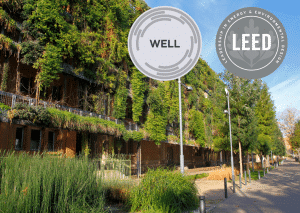Alongside LEED, there is another Green Building rating system that is growing in popularity in the United States and Canada, known as Green Globes. The Green Globes rating system is very interactive and flexible for the users and provides information and guidance for the design, operation, and management of Green Buildings. Through Green Globes, builders can obtain the third-party assessment of the environmental aspects of the building and receive recognition through the rating system. Both LEED and Green Globes assess a wide range of buildings and have similarities in their rating systems. As LEED gains popularity around the world, it is worth taking a look at the other rating system that is gaining popularity in the United States and Canada.
The History of Green Globes
ECD Energy and Environmental Canada developed the Green Globes rating system in Canada in 2000. This system was based off of BREEAM, which was developed in the UK in the 1980’s. Many other Green Building rating systems, including LEED, were based off of BREEAM. As the Green Globes system was refined, it gained popularity and eventually the support of the Canadian Department of National Defense and Public Works and Government Services.
In Canada, Green Globes is administered by the Building Owners and Managers Association (BOMA Canada) and has recently been re-branded as BOMA BESt or rather, Building Owners and Managers Association Building Environmental Standards. In 2013, it was determined that there were over 3,000 buildings certified or recertified throughout Canada using this system. Each year, a report is released that analyzes the performance of the buildings certified under Green Globes.
In 2004, Green Globes was adapted for use in the United States and was administered through the Green Building Initiative (GBI). The GBI is a standards developer through the American National Standards Institute (ANSI). Since the introduction of Green Globes into the United States, the assessments have undergone many different updates in an effort to compete with LEED. The Green Globes rating system can apply to both new and existing buildings. Since the introduction of Green Globes to the United States, the system has gone through numerous updates to include more building types and more efficient modules.
A Comparison of LEED and Green Globes Categories
The LEED rating system has nine different credit categories from which project teams can obtain points for certification including: integrative process, location and transportation, sustainable sites, water efficiency, energy and atmosphere, materials and resources, indoor environmental quality, innovation, and regional priority. Green Globes only has seven different categories from which points are obtained including: site, energy, water, emissions, project management, indoor environment, and materials and resources.
Comparing the Certification Steps in LEED and Green Globes
It is undeniable that the United States is one of the major world powers and when the United States created LEED, many other counties adopted the system or created their own based upon LEED. Within the United States, Green Globes and LEED are often compared and many debate which system is the superior system. While LEED has more worldwide recognition than Green Globes, it is important to understand the differences between the two systems.
The Green Globes rating system is designed to be a self-assessment, using a project manager and design team. The language that is used to explain the Green Globes rating system is specifically worded that caters to beginners. LEED requires in-depth knowledge of how their system works. Green Globes uses online questionnaires that give useful information pertinent to the project. Once the questionnaires are completed, the system will provide the project team with a report of the highlights of the project and indicate areas that could be improved upon. The Green Globes online system allows users to keep the assessment up-to-date and serves as a virtual consultant that provides feedback to the users. There is a wide range of information that is available to users online, including a manual and a tool that shows how the points are going to be awarded.
Obtaining the certification differs in a few notable ways between Green Globes and LEED, in terms of price, ease of use, sustainability, and scoring. LEED is much more expensive when it comes to consulting fees that are required. However, Green Globes has much higher project fees than LEED. Green Globes is also a much simpler system to use and requires fewer registrations fees than LEED. In terms of sustainability, LEED has more stringent standards than Green Globes. However, LEED continues to revise and adapt their system to make it more user friendly. Green Globes accepts four different forest certifications including: FSC, SFI, ATFC, CSA whereas LEED only accepts FSC.
The Differences in the Rating Systems in LEED and Green Globes
As discussed previously, in order to obtain a certification with LEED, a project needs to earn a certain numbers of points to obtain the various levels of certification. In total, there are 100 points that can be earned by a project team, with 10 bonus points that can be obtained as well. There are four different levels of LEED certification, respectively: certified, silver, gold, and platinum. To obtain a basic LEED certification, a project team needs to earn between 40-49 of the total 100 points. In order to achieve higher levels of certification, project teams will need to earn more points. A LEED Silver certification required 50-59 points, a LEED Gold certification requires 60-79 points, and a LEED Platinum certification requires the project team to obtain over 80 of the 100 points available.
The Green Globes system works in a similar fashion, with the four levels of certification. The approach that Green Globes takes to allow project teams to achieve certification is designed to allow a team to produce the most sustainable outcomes based on the buildings type and purpose, using a more customized approach. Green Globes allows more project team members to access and upload information concerning the project, saving time in terms coordination and documentation.
When working with the LEED rating system, the project team needs to submit templates online. Whereas with Green Globes, the project team needs to complete online questionnaires. Unlike the LEED system, where there are a 100 possible points and ten bonus points, the Green Globes system has a total of 1,000 points that can be achieved. In order to achieve the most basic level of certification and earn one Green Globe, a project team needs to earn at least 35%-54% of the total 1,000 points. In order to obtain two Green Globes, a project team will need to earn between 55%-69% of the total 1,000 points. To obtain three Green Globes, a project team will need to earn up to 70%-84% of the total 1,000 points and to achieve the highest level of Green Globes certification, earning four Green Globes, a project team will need to earn over 85% of the 1,000 available points.
In terms of how points are awarded, there are some differences between the Green Globes rating system and LEED. In the LEED rating system, partial credits and recognition that some criteria may not be applicable to the project is only taken into consideration in a limited manner whereas Green Globes is far more flexible. The LEED rating system frequently requires prerequisites to many of their credits, whereas Green Globes does not require any prerequisites. It should also be noted that Green Globes uses life cycle assessment and multiple attribute evaluations, whereas LEED does not use this.
The Impact of Green Globes and LEED
While it is an undeniable fact that the Green Globes rating system is a very good rating system and has many useful tools for builders who are seeking to create a Green Building. LEED is the more popular system, however, it is important to not glorify one system above the other. Rather, it is important to take a look at the different rating systems and see what can be done to improve the functionality of both. One may ask why it is necessary to have multiple rating systems, as it having multiple systems in place may lead to confusion and disorganization. But, as the saying goes, two heads are better than one, and the same logic can be applied to Green Building rating systems.
While the criteria in many of the Green Building rating system is similar, the way that the assessment methodologies are delivered differs. This diversity amongst the various systems is important, as it allows the builders to choose the system that best suits their needs and allows for growth and development amongst the systems. However, in order to continue to improve the Green Building rating systems, it is important to not put one system over the other. Rather, the positive and negative points of both systems should be assessed and steps should be taken to improve the negative points. It is important to keep the main goal in mind when looking at these different Green Building rating systems, that our purpose is to create more efficient Green Buildings.











